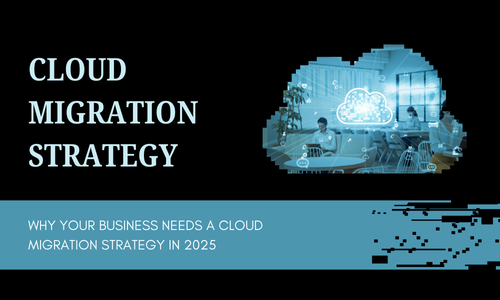Why Your Business Needs a Cloud Migration Strategy in 2025

How to Boost Business by Social Media Marketing 2025
March 12, 2025
CRM in 2025: How AI is Redefining Customer Relationships
March 20, 2025In today’s fast-paced digital world, businesses must adapt to stay competitive, and a well-planned cloud migration strategy is no longer optional—it’s essential. As we step into 2025, the reliance on cloud technology has skyrocketed, offering unparalleled flexibility, scalability, and cost-efficiency. Whether you’re a small startup or an established enterprise, moving your operations to the cloud can transform how you work, collaborate, and grow. This blog explores why cloud migration is a game-changer and how it can future-proof your business.
The Growing Importance of Cloud Migration in 2025
Technology is evolving at lightning speed, and 2025 is set to be a pivotal year for digital transformation. Companies that delay cloud migration risk falling behind competitors who are already leveraging cloud-based solutions to streamline operations. The cloud offers a way to store data securely, access advanced tools, and scale resources as needed—all while reducing the burden of maintaining physical infrastructure. With remote work and global markets on the rise, a cloud migration strategy ensures your business stays agile and ready for what’s next.
Benefits of Cloud Migration for Your Business
Adopting a cloud migration plan brings a host of advantages that can propel your business forward. Here’s why it’s worth the investment:
1. Cost Efficiency and Savings
Moving to the cloud eliminates the need for expensive on-premises servers and maintenance. With a cloud migration approach, you pay only for what you use, optimizing your budget and freeing up resources for innovation.
2. Enhanced Scalability
As your business grows, so do your tech needs. Cloud platforms allow you to scale up or down effortlessly, ensuring you’re never overpaying or under-resourced. This flexibility is a cornerstone of any successful cloud migration strategy.
3. Improved Security
Cybersecurity threats are a top concern in 2025, and cloud providers invest heavily in cutting-edge security measures. A strategic cloud migration ensures your data is protected with regular updates and advanced encryption.
4. Better Collaboration
With teams working remotely or across multiple locations, cloud-based tools foster seamless collaboration. Migrating to the cloud means your employees can access files and applications from anywhere, boosting productivity.
Why 2025 Is the Perfect Time for Cloud Migration
The business landscape in 2025 is shaped by rapid technological advancements, from AI integration to real-time data analytics. Companies that embrace cloud migration now can harness these innovations without the limitations of outdated systems. Plus, with increasing customer expectations for speed and reliability, a cloud migration strategy positions you to deliver exceptional experiences. Waiting longer could mean higher costs and missed opportunities as competitors take the lead.
Steps to Build an Effective Cloud Migration Strategy
Ready to make the leap? A successful cloud migration doesn’t happen overnight—it requires careful planning. Here’s how to get started:
1. Assess Your Current Infrastructure
Evaluate your existing systems to identify what’s ready for cloud migration and what needs upgrading. This step ensures a smooth transition.
2. Choose the Right Cloud Model
Public, private, or hybrid—each option has its perks. Your cloud migration strategy should align with your business goals and budget.
3. Partner with Experts
Work with a trusted cloud provider or consultant to guide your cloud migration. Their expertise can help you avoid common pitfalls.
4. Test and Optimize
Before fully committing, test your migrated systems to ensure everything runs smoothly. Post-migration tweaks will maximize performance.
Overcoming Common Cloud Migration Challenges
While the benefits are clear, cloud migration can come with hurdles. Data security concerns, downtime during the switch, and employee training are common issues. However, with a solid cloud migration plan, these challenges can be mitigated. Partnering with a reliable provider and preparing your team in advance will keep your transition on track.
The Future of Business Lies in Cloud Migration
Looking ahead, the cloud isn’t just a trend—it’s the foundation of modern business. By 2025, companies without a cloud migration strategy risk being left behind as industries shift toward fully digital ecosystems. Whether it’s improving efficiency, cutting costs, or staying competitive, migrating to the cloud is a smart move that pays off in the long run.
There’s no better time than 2025 to rethink how your business operates. A cloud migration strategy isn’t just about keeping up—it’s about getting ahead. Start planning now, and unlock the potential of the cloud to drive growth, innovation, and success for years to come. Ready to transform your business? The cloud is waiting.


